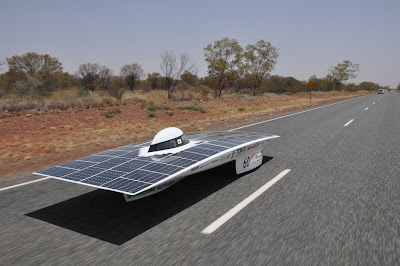Solar Car
Definition
Thermo acoustic have been known for over years but the use of this phenomenon to develop engines and pumps is fairly recent. Thermo acoustic refrigeration is one such phenomenon that uses high intensity sound waves in a pressurized gas tube to pump heat from one place to other to produce refrigeration effect. In this type of refrigeration all sorts of conventional refrigerants are eliminated and sound waves take their place. All we need is a loud speaker and an acoustically insulated tube. Also this system completely eliminates the need for lubricants and results in 40% less energy consumption. Thermo acoustic heat engines have the advantage of operating with inert gases and with little or no moving parts, making them highly efficient ideal candidate for environmentally-safe refrigeration with almost zero maintenance cost. Now we will look into a thermo acoustic refrigerator, its principle and functions .Basic Functioning
In a nut shell, a thermo acoustic engine converts heat from a high-temperature source into acoustic power while rejecting waste heat to a low temperature sink. A thermo acoustic refrigerator does the opposite, using acoustic power to pump heat from a cool source to a hot sink. These devices perform best when they employ noble gases as their thermodynamic working fluids. Unlike the chemicals used in refrigeration over the years, such gases are both nontoxic and environmentally benign. Another appealing feature of thermo acoustics is that one can easily flange an engine onto a refrigerator, creating a heat powered cooler with no moving parts at all.The principle can be imagined as a loud speaker creating high amplitude sound waves that can compress refrigerant allowing heat absorption. The researches have exploited the fact that sound waves travel by compressing and expanding the gas they are generated in.
Suppose that the above said wave is traveling through a tube. Now, a temperature gradient can be generated by putting a stack of plates in the right place in the tube, in which sound waves are bouncing around. Some plates in the stack will get hotter while the others get colder. All it takes to make a refrigerator out of this is to attach heat exchangers to the end of these stacks.
It is interesting to note that humans feel pain when they hear sound above 120 decibels, while in this system sound may reach amplitudes of 173 decibels. But even if the fridge is to crack open, the sound will not be escaping to outside environment, since this intense noise can only be generated inside the pressurized gas locked inside the cooling system. It is worth noting that, prototypes of the technology has been built and one has even flown inside a space shuttle.
Thermo acoustic refrigerators now under development use sound waves strong enough to make your hair catch fire, says inventor Steven L Garrett. But this noise is safely contained in a pressurized tube. If the tube gets shattered, the noise would instantly dissipate to harmless levels. Because it conducts heat, such intense acoustic power is a clean, dependable replacement for cooling systems that use ozone destroying chlorofluorocarbons (CFCs). Now a scientist Hofler is also developing super cold cryocoolers capable of temperatures as low as -135°F (180°K). he hopes to achieve -243°F (120°K) because such cryogenic temperatures would keep electronic components cool in space or speed the function of new microprocessors.


Comments